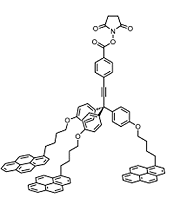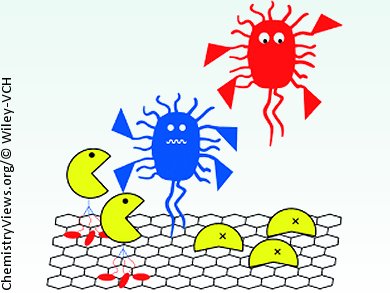Scientists at Cornell University, USA, have shown that anti-Escherichia coli antibodies (aEABs) retain their ability to recognize E. coli cells when they are attached to a self-assembled monolayer (SAM) of tripodal molecules that is bound to single-layer graphene (SLG). In contrast, when the aEABs are directly adsorbed onto SLG, they lose their specific recognition ability. The tripodal molecule (pictured) that Harold G. Craighead, William R. Dichtel, and their team used bears three pyrene “feet” that interact with the SLG to create stable monolayers.

When the monolayers are functionalized with aEABs, E. coli cells are captured and divide to form a biofilm on the SLG surface. The density of bound cells was shown to be five times higher for the tripodal molecules than for a SAM of monovalent molecules or nonfunctionalized SLG. Furthermore, E. coli cells that were immobilized on nonfunctionalized SLG did not remain attached to the surface. The authors hope that this antibody binding specificity can be applied to the investigation of practical SLG-based biosensors.
- Preservation of Antibody Selectivity on Graphene by Conjugation to a Tripod Monolayer,
Jason A. Mann, Thomas Alava, Harold G. Craighead, William R. Dichtel,
Angew. Chem. Int. Ed. 2013.
DOI: 10.1002/anie.201209149



